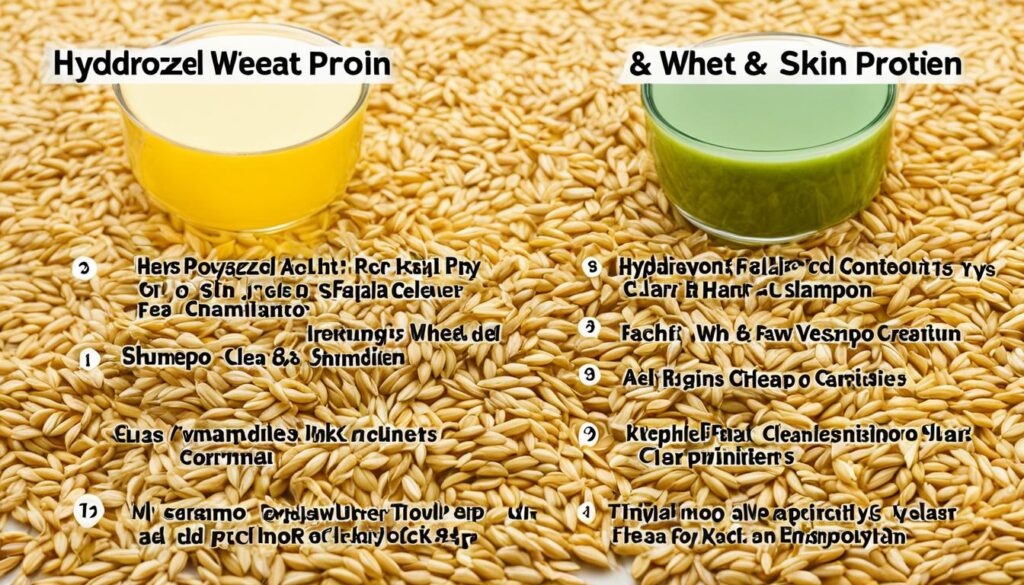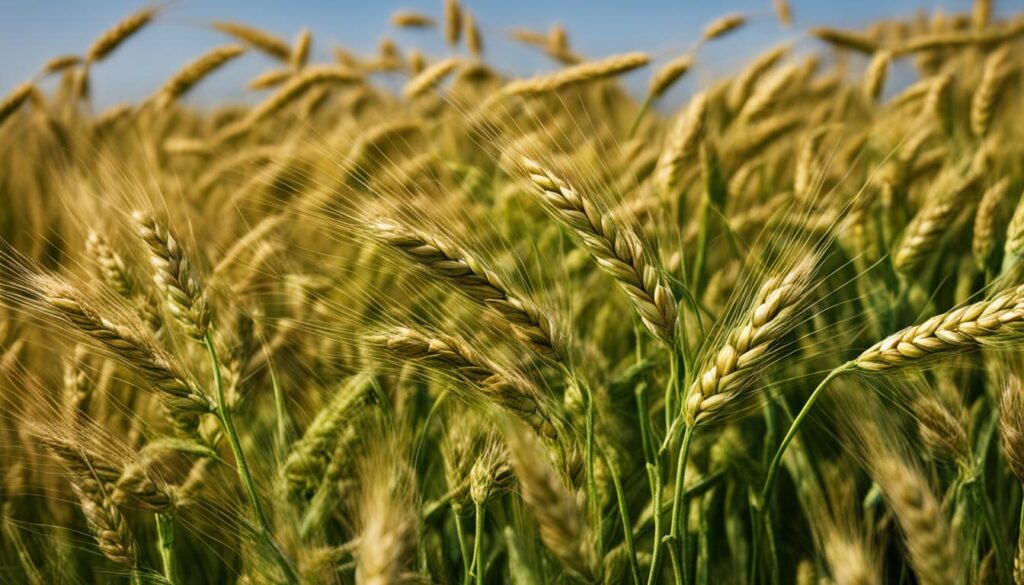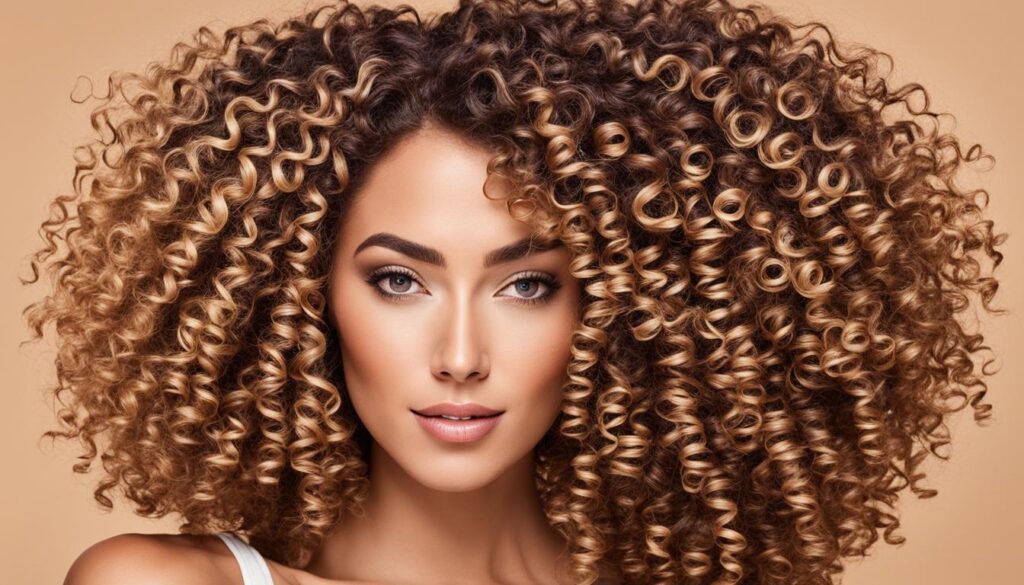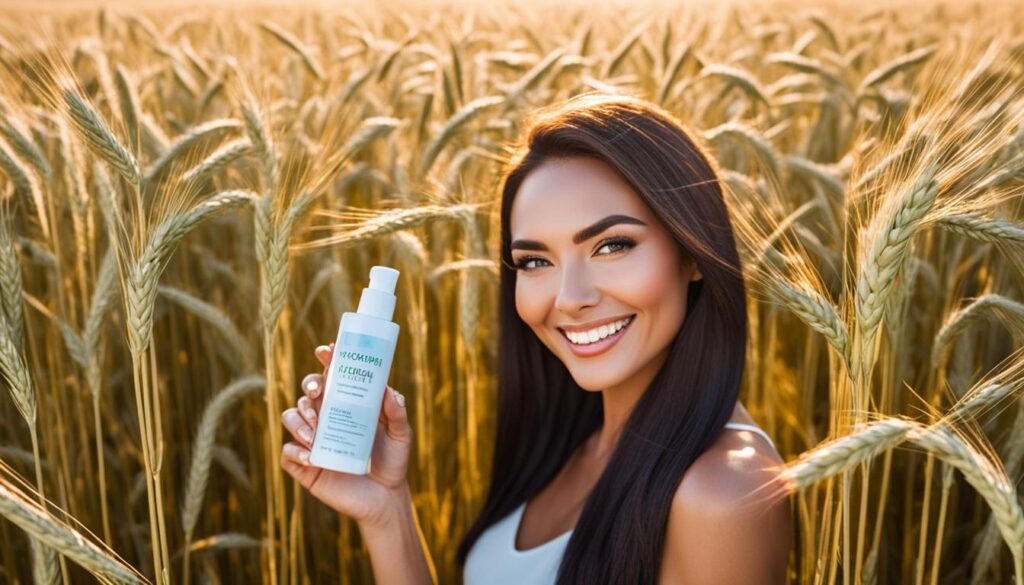Wheat protein, specifically hydrolyzed wheat protein, is a remarkable ingredient with numerous benefits for both hair and skin. Derived from wheat germ, this protein is known for its hydrating and strengthening properties, making it a popular choice in hair and skincare products. Whether you have curly, dry, color-treated, or damaged hair, hydrolyzed wheat protein can work wonders.
Key Takeaways:
- Hydrolyzed wheat protein strengthens the hair shaft, provides moisture, prevents breakage, and adds shine.
- It helps maintain an optimum moisture balance in the skin, resulting in a smoother and softer texture.
- Individuals with wheat or gluten sensitivities should avoid products containing wheat protein.
- Hydrolyzed wheat protein undergoes hydrolysis, a process that breaks down protein molecules into smaller fragments for better absorption.
- It is safe to use in skincare products and can benefit individuals with different skin types.
The Science Behind Hydrolyzed Wheat Protein

Hydrolyzed wheat protein is a key ingredient in hair and skincare products, but have you ever wondered how it works its magic? Let’s delve into the science behind this remarkable protein.
Hydrolyzed wheat protein undergoes a process called hydrolysis, where the protein molecules are broken down into smaller fragments with lower molecular weights. This makes it easier for the hair to absorb the protein and reap its benefits.
When applied to the hair, hydrolyzed wheat protein increases its elasticity, controls moisture loss, and improves flexibility. It repairs damage and replenishes the void of keratin, making it an ideal choice for chemically treated or damaged hair. Additionally, it adds volume to the hair shafts and creates a glossy, silky film on the hair’s surface, promoting a healthy and vibrant appearance.
In skincare products, hydrolyzed wheat protein plays a crucial role in maintaining the moisture balance of the skin. By providing hydration and forming a protective barrier, it helps the skin retain moisture, resulting in a smoother and softer texture.
Now that we’ve explored the science behind hydrolyzed wheat protein, you can better understand why it’s a sought-after ingredient in the beauty industry. Its ability to enhance the health and appearance of both hair and skin makes it a valuable addition to your beauty routine.
The Benefits of Hydrolyzed Wheat Protein:
- Increases hair elasticity
- Controls moisture loss
- Improves hair flexibility
- Repairs damaged hair
- Replenishes keratin void
- Adds volume to hair shafts
- Creates a glossy, silky film on hair surface
- Maintains moisture balance in the skin
- Provides a smoother and softer texture to the skin
How to Incorporate Hydrolyzed Wheat Protein into Your Hair Care Routine

Hydrolyzed wheat protein offers numerous benefits for your hair, and there are several ways to include it in your hair care routine. Whether you prefer adding it to your existing products or using specialized wheat protein-infused products, there are options to suit your needs and preferences.
1. Enhancing Your Existing Products:
You can customize your shampoo and conditioner by adding hydrolyzed wheat protein. Simply mix a small amount of the protein powder with your favorite products and use them as usual. This method allows you to enjoy the benefits of wheat protein without having to invest in new products.
2. Using as a Leave-In Treatment:
You can use hydrolyzed wheat protein as a leave-in treatment by applying a small amount to your damp hair after showering. Gently massage it into your hair, focusing on the mid-lengths and ends. This method provides continuous hydration and nourishment throughout the day.
3. Applying as a Deep Conditioning Treatment:
For a more intensive treatment, you can apply hydrolyzed wheat protein as a deep conditioning treatment. After shampooing, apply a generous amount of the protein-infused product to your hair and leave it on for the recommended time. Rinse thoroughly and style as desired. This method helps repair and strengthen damaged hair.
Remember, the concentration and formulation of the product will determine how much and how often you should use hydrolyzed wheat protein. It’s important to follow the instructions provided by the manufacturer for optimal results.
Hydrolyzed Wheat Protein-Infused Products
In addition to customizing your own hair care products, you can also find a variety of wheat protein-infused products on the market. These products are formulated with hydrolyzed wheat protein and offer targeted benefits for specific hair concerns. Some popular options include:
| Product | Description |
|---|---|
| Kiehl’s Rice and Wheat Volumizing Shampoo | A volumizing shampoo that adds body to fine hair while nourishing it with hydrolyzed wheat protein. |
| L’Oreal Elvive Total Repair Extreme Renewing Conditioner | A conditioner that repairs and strengthens damaged hair, thanks to the hydrolyzed wheat protein infusion. |
| Kerastase Nutritive Masquintense Thick Hair Mask | A deep conditioning mask that deeply nourishes and moisturizes thick hair with the help of hydrolyzed wheat protein. |
These are just a few examples, and there are many more wheat protein-infused products available in the market. When choosing a product, consider your hair type and specific concerns, and read the labels to ensure they contain hydrolyzed wheat protein.
However, it’s always recommended to perform a patch test before using new hair care products, especially if you have sensitive skin or allergies. This will help prevent any adverse reactions and ensure that the product suits your hair and scalp.
By incorporating hydrolyzed wheat protein into your hair care routine, whether through customized products or wheat protein-infused options, you can enjoy the hydrating, strengthening, and nourishing benefits this protein provides.
Incorporate hydrolyzed wheat protein into your hair care routine for healthier, stronger hair.
Hydrolyzed Wheat Protein for Healthy Skin

Hydrolyzed wheat protein offers a multitude of benefits not only for hair but also for the skin. When included in skincare products, this protein delivers exceptional moisturization, improves the skin’s moisture balance, and forms a protective film on its surface. The film created by hydrolyzed wheat protein aids in retaining moisture, resulting in a smoother and softer feel for the skin.
This versatile ingredient can be incorporated into various skincare products such as lotions, creams, serums, and body washes to enhance their hydrating properties further. The use of hydrolyzed wheat protein in skincare formulations is safe and suitable for individuals with different skin types, making it a valuable addition to any skincare routine.
By utilizing the film-forming benefits of hydrolyzed wheat protein, skincare products can effectively lock in moisture and support the skin’s natural hydration levels. This not only helps improve the skin’s overall appearance but also contributes to its health and well-being.
When selecting skincare products, it is important to be mindful of individual sensitivities. Performing a patch test before incorporating new products into your skincare routine will help ensure compatibility and minimize the risk of adverse reactions.
The Benefits of Hydrolyzed Wheat Protein for Healthy Skin
| Skincare Benefits of Hydrolyzed Wheat Protein |
|---|
| Provides deep moisturization |
| Improves the skin’s moisture balance |
| Forms a protective film on the skin’s surface |
| Aids in retaining moisture |
| Gives the skin a smoother and softer feel |
Hydrolyzed wheat protein is a valuable ingredient that supports and enhances the overall health of the skin. Its moisturizing and film-forming properties make it an excellent addition to skincare products, providing long-lasting hydration and maintaining the skin’s natural moisture balance.
Choosing the Right Products with Hydrolyzed Wheat Protein

When it comes to incorporating hydrolyzed wheat protein into your hair and skincare routine, choosing the right products is essential. Opting for reputable brands that prioritize the quality and effectiveness of their ingredients ensures you get the maximum benefits of wheat protein-infused products. Whether you’re looking for haircare or skincare products, there are plenty of options available.
Haircare Products
If you’re seeking wheat protein-infused haircare products, consider the following highly recommended options:
| Product | Brand |
|---|---|
| Kiehl’s Rice and Wheat Volumizing Shampoo | Kiehl’s |
| L’Oreal Elvive Total Repair Extreme Renewing Conditioner | L’Oreal |
| Kerastase Nutritive Masquintense Thick Hair Mask | Kerastase |
These products are formulated with hydrolyzed wheat protein to provide hydrating, strengthening, and nourishing properties for your hair.
Skincare Products
If you’re looking for wheat protein-infused skincare products, consider lotions, creams, and serums that offer the following benefits:
- Improved moisture balance
- Enhanced hydration
- Smoothing and softening effects
When choosing skincare products with hydrolyzed wheat protein, read the product labels and look for renowned brands that prioritize the quality and effectiveness of their ingredients.
By selecting the right products with hydrolyzed wheat protein, you can experience the hydrating and strengthening benefits for both your hair and skin.
Precautions and Frequency of Use

While hydrolyzed wheat protein offers numerous benefits, it is crucial to use it in moderation to avoid any negative effects on your hair texture. The frequency of use can vary depending on the product formulation and strength. To maintain healthy hair, it is recommended to use hydrolyzed wheat protein once every four to six weeks. Some individuals may prefer more frequent treatments, using it every four to five weeks, while others may choose to space out their usage. It’s essential to find a frequency that works best for your hair and scalp.
Overusing hydrolyzed wheat protein can lead to hair becoming brittle and prone to breakage. The protein is designed to strengthen and nourish the hair, but too much of it can have the opposite effect. Excessive use of wheat protein can disrupt the natural balance of the hair, causing it to lose its elasticity and become more susceptible to damage. It is important to follow the recommended usage guidelines provided by the product manufacturer.
It is worth noting that using other forms of hair protein simultaneously can also contribute to overuse. Combining multiple protein treatments can overload the hair, resulting in dryness and potential protein overload. It’s best to stick to one protein treatment at a time to prevent any negative effects on the hair texture.
Recommended Usage Guidelines for Hydrolyzed Wheat Protein
If you are uncertain about the optimal frequency of use for a specific hydrolyzed wheat protein product, consult the instructions provided by the manufacturer. They will typically indicate the recommended usage guidelines based on the formulation and concentration of the protein.
Here is a general guideline, assuming the product is designed for regular use:
| Frequency of Use | Interval |
|---|---|
| Once a week | For a more intensive treatment |
| Once every two weeks | For maintenance and upkeep |
| Once a month | For minimal maintenance |
These are general guidelines and can vary depending on the individual’s hair type, condition, and response to the hydrolyzed wheat protein treatment. It is always advisable to monitor your hair’s texture and adjust the frequency of use accordingly.
Understanding the Effectiveness of Hydrolyzed Wheat Protein
Hydrolyzed wheat protein is a powerful ingredient when it comes to repairing damaged hair and reducing hair breakage. Its unique properties allow it to connect broken bonds within the hair, resulting in stronger and healthier locks. But that’s not all—hydrolyzed wheat protein also provides essential hydration to the hair shaft, locking in moisture and preventing dryness, a leading cause of hair breakage. By improving the overall health and elasticity of the hair, it can even help minimize hair loss.
In addition to its repairing properties, hydrolyzed wheat protein also adds a lustrous shine to the hair, giving it a thicker and fuller appearance. Although it may not directly promote hair growth, its ability to enhance the overall look of the hair creates the illusion of increased volume.
Whether your hair is damaged from heat styling, chemical treatments, or environmental factors, incorporating products with hydrolyzed wheat protein into your hair care routine can make a significant difference. By nourishing and strengthening your strands, this protein will leave your hair looking and feeling healthier than ever before.
Who Should Use Hydrolyzed Wheat Protein

Hydrolyzed wheat protein is a versatile ingredient that offers benefits for individuals with different hair concerns. It is particularly advantageous for those with curly, dry, color-treated, or damaged hair. The hydrating and strengthening properties of hydrolyzed wheat protein can help improve the health and appearance of these hair types.
For individuals with curly hair, hydrolyzed wheat protein helps to define and enhance natural curls, adding bounce and elasticity. It provides moisture to dry hair, reducing frizz and promoting a healthier, more manageable mane.
For those with color-treated hair, hydrolyzed wheat protein helps to repair and protect the hair shaft, minimizing damage caused by chemicals. It improves color retention and adds shine, enhancing the vibrancy and longevity of the color.
Individuals with damaged hair benefit from the reparative properties of hydrolyzed wheat protein. It helps to strengthen and rebuild the hair structure, reducing breakage and restoring vitality to damaged strands.
Moreover, hydrolyzed wheat protein may provide benefits to individuals with thinning hair. It helps to minimize breakage and improve hair thickness, creating the appearance of fuller, denser hair.
However, it’s important to note that individuals with wheat or gluten sensitivities should avoid products containing hydrolyzed wheat protein. They can opt for alternative products that cater to their specific needs.
The Benefits of Using Hydrolyzed Wheat Protein in Cosmetics

Hydrolyzed wheat protein offers several benefits when used in cosmetics. It helps maintain the moisture balance in the skin, resulting in a smoother and softer texture. The protein’s film-forming properties create a protective barrier on the skin’s surface, improving its overall appearance. This hydrating complex is highly effective in adding moisture to lotions, creams, serums, and body washes. By incorporating hydrolyzed wheat protein into cosmetic formulations, brands can enhance the hydrating properties of their products and provide added benefits to the skin.
| Benefits of Hydrolyzed Wheat Protein in Cosmetics | Description |
|---|---|
| 1. Maintains Moisture Balance | Hydrolyzed wheat protein helps retain moisture, keeping the skin hydrated and preventing dryness. |
| 2. Film-Forming Properties | The protein forms a protective film on the skin, improving its appearance and texture. |
| 3. Enhances Hydration | The hydrating complex of hydrolyzed wheat protein adds moisture to lotions, creams, serums, and body washes, providing long-lasting hydration. |
Incorporating hydrolyzed wheat protein into cosmetic products can be particularly beneficial for individuals with dry or dehydrated skin. The moisture-retaining properties of the protein help replenish and balance the skin’s natural hydration levels. Additionally, the film-forming properties create a barrier that locks in moisture, ensuring the skin stays hydrated throughout the day.
Unlocking Nature’s Secret to Beauty and Strength with Hydrolyzed Wheat Protein
Hydrolyzed wheat protein is a remarkable ingredient that offers a range of benefits for both hair and skin. Its hydrating and strengthening properties make it a popular choice for individuals looking for natural and holistic personal products. By incorporating hydrolyzed wheat protein into their hair care and skincare routines, individuals can unlock the secret to beauty and strength that nature has to offer.
When it comes to hair health, hydrolyzed wheat protein shines. Not only does it repair damaged hair and add shine and volume, but it also improves the overall appearance and texture of the hair. This versatile ingredient strengthens the hair shaft, prevents breakage, and enhances moisture balance, resulting in lustrous, fuller-looking locks. Whether you have curly, dry, color-treated, or damaged hair, hydrolyzed wheat protein is the go-to solution for revitalizing and nourishing your hair.
But the benefits don’t stop there. Hydrolyzed wheat protein also works wonders for the skin. By incorporating this ingredient into skincare products, you can achieve a smoother and softer complexion. Its hydrating properties help maintain the skin’s moisture balance, while its film-forming benefits create a protective barrier that locks in moisture. Whether it’s lotions, creams, serums, or body washes, hydrolyzed wheat protein adds an extra boost of hydration, leaving your skin healthy, radiant, and rejuvenated.
Looking for a natural approach to beauty and strength? Look no further than hydrolyzed wheat protein. With its unique blend of benefits for both hair and skin, this ingredient is a game-changer in the world of holistic beauty. Discover the incredible transformation that hydrolyzed wheat protein can bring to your hair and skin, and unlock nature’s secret to beauty and strength today.
FAQ
What are the benefits of hydrolyzed wheat protein for hair and skin?
Hydrolyzed wheat protein strengthens the hair shaft, adds moisture, prevents breakage, and enhances shine. In skincare products, it helps maintain a moisture balance and gives the skin a smoother and softer texture.
How does hydrolyzed wheat protein work?
Hydrolyzed wheat protein increases hair elasticity, controls moisture loss, repairs damage, and replenishes keratin. In skincare products, it forms a protective film, improves the skin’s moisture balance, and provides hydration.
How can I incorporate hydrolyzed wheat protein into my hair care routine?
Hydrolyzed wheat protein can be added to shampoos, conditioners, used as a leave-in treatment, or applied as a deep conditioning treatment. The concentration and formulation of the product will determine the amount and frequency of use.
Is hydrolyzed wheat protein suitable for all skin types?
Hydrolyzed wheat protein is safe and can be suitable for individuals with different skin types. However, it is important to consider individual sensitivities and perform a patch test before using new products.
What are some recommended hair care products containing hydrolyzed wheat protein?
Some recommended products include Kiehl’s Rice and Wheat Volumizing Shampoo, L’Oreal Elvive Total Repair Extreme Renewing Conditioner, and Kerastase Nutritive Masquintense Thick Hair Mask.
How often should I use hydrolyzed wheat protein?
The frequency of use can vary based on the product formulation and strength. On average, it is recommended to use hydrolyzed wheat protein once every four to six weeks.
What are the benefits of hydrolyzed wheat protein for damaged hair?
Hydrolyzed wheat protein repairs damaged hair, reduces hair breakage, adds shine, and gives the hair a thicker appearance.
Who can benefit from using hydrolyzed wheat protein?
Hydrolyzed wheat protein is beneficial for individuals with curly, dry, color-treated, or damaged hair. It can also provide benefits for individuals with thinning hair by minimizing breakage and improving hair thickness.
What are the benefits of using hydrolyzed wheat protein in cosmetics?
Hydrolyzed wheat protein helps maintain the moisture balance in the skin, forms a protective film, and enhances the hydrating properties of lotions, creams, serums, and body washes.
How can hydrolyzed wheat protein contribute to holistic beauty and strength?
By incorporating hydrolyzed wheat protein into their hair care and skincare routines, individuals can unlock nature’s secret to beauty and strength, improving hair health and skin health.






